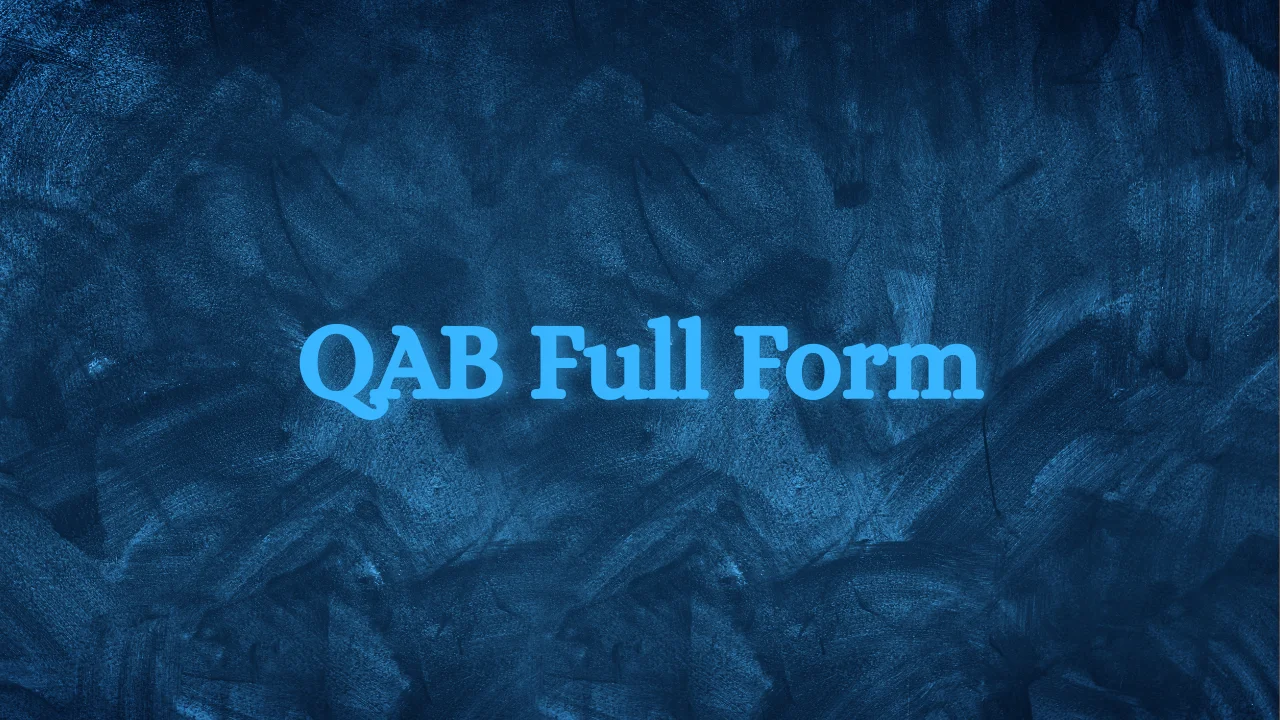QAB Full Form in Banking and Finance and Other Fields 2025

Banking terms often confuse people, especially when banks use short forms like QAB full form. These terms look small but carry big meaning. In the same way you might have heard of MSVP Full Form, QAB is also vital when dealing with money in your savings or current account.
This blog explains what QAB form means, why banks use it, how it is calculated, its benefits, and examples from real banks. By the end, you will be confident about this important banking term.
| Term | Full Form | Field of Use | Importance |
|---|---|---|---|
| QAB | Quarterly Average Balance | Banking and Finance | Required balance rule for savings and current accounts |
| MSVP | Minimum Standard Value of Property | Finance and Insurance | Helps define property value standards for agreements |
QAB Full Form in Banking and Finance
In the world of banking, QAB form means Quarterly Average Balance. This is the most common usage of the term. Banks require customers to maintain a certain average balance in their savings or current accounts over three months.
If the balance falls below the required QAB, the bank charges a penalty. Knowing this helps customers avoid unnecessary fees and plan their finances better.
QAB Form in Healthcare
In healthcare, QAB form refers to Quick Aphasia Battery. This is a medical test used to evaluate patients who have speech and language problems, often after a stroke or brain injury.
The Quick Aphasia Battery allows doctors to quickly assess communication abilities and plan treatment. While this usage is less common for the general public, it is very important in clinical practice.
QAB in Governance and Quality Management
In governance and quality control, QAB form stands for Quality Assurance Board. This board oversees and monitors standards in organizations, ensuring products or services meet required guidelines.
The Quality Assurance Board plays a key role in maintaining trust, compliance, and accountability. It is widely used in industries where strict rules of quality are followed, such as education, engineering, and manufacturing.
QAB Form in Accounting and Business
In some contexts, especially in accounting, QAB form may also mean Quarterly Account Balance. This version is used in financial reports where businesses review their performance every three months. By looking at quarterly balances, companies track growth, expenses, and profits more effectively. This helps investors and managers understand the financial health of a business.
QAB Form and Its Role in Customer Trust
Banks rely on the qab form rule to build trust with their customers. When people understand how Quarterly Average Balance works, they feel more secure in managing accounts.
It removes confusion about penalties and creates a transparent relationship between the bank and its clients. In the long run, this clarity strengthens customer confidence and loyalty.
QAB Form and Changing Trends in E-Banking
With the rise of digital banks, the importance of qab form has changed. Many online banks promote zero-balance accounts to attract users. Still, traditional banks continue to enforce QAB rules for stability.
This difference creates two types of banking experiences: flexible digital banking with fewer rules, and conventional banking where QAB ensures regular deposits and balance control.
QAB Form and Its Effect on Financial Planning
Understanding the qab form also helps in personal financial planning. By keeping track of your Quarterly Average Balance, you learn discipline in saving money. This habit encourages people to keep reserves for emergencies and ensures smoother money management.
It also prepares customers for bigger financial steps like loans, investments, or premium accounts that demand higher balances.
Why Banks Use QAB
Banks use QAB to ensure they have funds for operations. It helps them manage liquidity and customer accounts efficiently.
For customers, knowing the qab form avoids hidden fees. It also helps you pick the right type of account.
Salary accounts often have zero QAB, while premium accounts may need a higher QAB. This is why banks clearly mention this rule when you open an account.
How to Calculate Quarterly Average Balance
Understanding the formula makes the qab form simple.
| Step | Action |
|---|---|
| 1 | Note the daily closing balance in your account for three months |
| 2 | Add up all daily balances |
| 3 | Count the total days in the quarter (usually 90) |
| 4 | Divide the sum of balances by the number of days |
Formula: QAB = (Sum of daily closing balances in a quarter) ÷ (Total days in the quarter).
Example: If you have ₹5,000 for 30 days and ₹10,000 for 60 days:
- Total = (30 × 5000) + (60 × 10000) = ₹750,000
- Divide by 90 days = ₹8,333 QAB
So your QAB is ₹8,333, not ₹10,000. This shows how daily balances impact the average.
QAB Rules in Indian Banks
Most Indian banks apply Quarterly Average Balance. Requirements vary by branch type and city.
| Bank | QAB Requirement | Penalty if Not Maintained |
|---|---|---|
| SBI | ₹3,000 in metro, ₹2,000 in semi-urban, ₹1,000 in rural | Up to ₹15 per month |
| HDFC Bank | ₹10,000 in savings account | ₹150–₹600 per quarter |
| ICICI Bank | ₹10,000 in metro branches | ₹100–₹350 per month |
| PNB | ₹2,000 in urban, ₹1,000 in semi-urban | ₹200 per quarter |
These figures show how important it is to know qab form before you choose an account.
Other Meanings of QAB
While in banking the qab form is Quarterly Average Balance, in other fields QAB can mean different things.
| Field | QAB Form | Meaning |
|---|---|---|
| Healthcare | Quick Aphasia Battery | A test for language problems after stroke |
| Governance | Quality Assurance Board | A committee ensuring quality standards |
| Finance | Quarterly Account Balance | Another variation used in accounting |
But when you deal with banks, remember that Quarterly Average Balance is the most relevant meaning.
Connection with ADG Full Form
Another useful term you may see in documents is ADG Full Form, which stands for Additional Deposit Guarantee. It is different from QAB, but both terms often appear together in banking contracts.
When you know qab full form and ADG full form, you can better understand the fine print of your account terms. This knowledge saves you from confusion and penalties.
QAB vs AMB
People often confuse QAB with AMB (Average Monthly Balance). Let’s compare.
| Feature | QAB (Quarterly Average Balance) | AMB (Average Monthly Balance) |
|---|---|---|
| Period | 3 months | 1 month |
| Flexibility | Allows low balances for some days if average is fine | Requires better planning month by month |
| Usage | Common in Indian banking | Used in many private banks |
Key difference: QAB measures balance over three months, while AMB measures it monthly.
Benefits of Knowing QAB
When you know the qab form, you gain several benefits.
- You avoid unnecessary penalties.
- You can plan deposits and withdrawals smartly.
- You can compare banks easily before choosing an account.
- You can maintain a good relationship with your bank.
Tips to Maintain QAB Easily
Maintaining your Quarterly Average Balance does not have to be stressful.
- Use mobile banking to track your daily balance.
- Set reminders to transfer money before month-end.
- Keep emergency funds in the same account to stay above the limit.
- Choose zero-QAB accounts if you cannot maintain the requirement.
Real-Life Example
Suppose you are an HDFC Bank customer. Your QAB requirement is ₹10,000.
- In April, you keep ₹8,000 daily.
- In May, you keep ₹12,000 daily.
- In June, you keep ₹10,000 daily.
Your average across 90 days is above ₹10,000. This means you meet the qab form condition even though April was lower.
QAB Full Form and Digital Banking

Digital banks and neobanks sometimes remove QAB rules to attract customers. They promote zero-balance accounts.
Still, major traditional banks follow the qab form strictly. Customers must choose whether they want flexibility or premium features.
How QAB Form Safeguards Your Finances
Many customers ignore account rules. Then, they are shocked when banks deduct ₹500 or more as penalty.
By knowing qab form, you take control. You can calculate, adjust, and avoid charges. This small knowledge makes a big difference in financial health.
Conclusion
The qab full form stands for Quarterly Average Balance. It is a simple but powerful rule that affects your savings or current account. Banks require you to maintain an average balance across three months. If you fall short, you pay a penalty.
We also looked at other meanings like Quick Aphasia Battery and Quality Assurance Board. But in banking, QAB is about your money. Along with MSVP Full Form and ADG Full Form, learning such terms makes you smarter with finance.
So next time you open a bank account, check the qab form requirement first. It will save you money, time, and stress.




